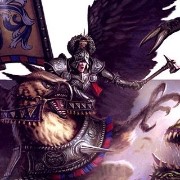HEY GAL posted:Early versions of the second go-round of breech loaded artillery, you mean. Some of the very earliest cannon were breech-loaded, because of the way you made the cannon (just like you'd make a barrel only with iron instead of wood--which is why we call it that). 14th century? drat, I never knew the concept of breach loading artillery pieces dated back that far!
|
|
|
|
|

|
| # ? May 9, 2024 11:41 |
|
On the other hand, I'm pretty sure a mis-chocked gun killed James II of Scotland so, you know, good sides and bad sides.
|
|
|
|
SocketWrench posted:Well, they were, among other deficiencies such as gas leaks and problems with the cartridges themselves, plus that old chestnut about the upper officers thinking men would waste ammo when they could make faster, easier reloads. Loading a muzzleloader teaches you respect and to value your shot Out of curiosity, to what extent did that fear pan out? Did the use of repeaters and breechloaders strain logistics significantly? Did accuracy decline?
|
|
|
|
KYOON GRIFFEY JR posted:Trenches and field fortifications were common well before the ACW. The only thing really different from an infantry company perspective in the ACW versus the Napoleonic Wars was the range of engagement. Trenches and field fortifications were a huge deal in Ireland from the Norman invasion right the way through to the 17th century. They're the only way the natives could effectively deal with the superior heavy cavalry of their enemies until the pike shows up in Gaelic hands in the 1580's, helped along by mercenaries returning home, renegade English captains and most importantly wrecked Spanish Armada survivors, but more on that later woohoo!
|
|
|
HEY GAL posted:On the other hand, I'm pretty sure a mis-chocked gun killed James II of Scotland so, you know, good sides and bad sides. Well to be fair, due to the casting techniques back then there was a chance that'd happen reguardless of how the cannon was loaded. King Jimmy knew the risks standing near a cannon. Rabhadh posted:Trenches and field fortifications were a huge deal in Ireland from the Norman invasion right the way through to the 17th century. They're the only way the natives could effectively deal with the superior heavy cavalry of their enemies until the pike shows up in Gaelic hands in the 1580's, helped along by mercenaries returning home, renegade English captains and most importantly wrecked Spanish Armada survivors, but more on that later woohoo! No man, don't leave us hanging!
|
|
|
|
|
Fangz posted:Out of curiosity, to what extent did that fear pan out? Did the use of repeaters and breechloaders strain logistics significantly? Did accuracy decline? Rifling became the mode (for infantry muskets) in the Napoleonic era, with plenty of use prior for specialist roles like snipers. So we're looking at a half century at least where warfare had transitioned or was transitioning (depending on the army) from volleys of nearly unaimed fire to aimed fire and unit skirmishing. Basically by the time proper repeaters came around (late 19th) to commonplace use, doctrine was already approaching aiming at the man rather than the formation. I wonder if repeating rifles were the late-war quantum leap in the ACW like the jet engine was for WWII. You had a massive jump in the rate of fire you could put out, but it was way too late to affect the ACW, much like the jet aircraft late in WWII were. Here was a plane that could outrun nearly everything else, but developed at a time when the war was all but decided. The next war saw prop planes relegated to support roles and night bombing.
|
|
|
|
HEY GAL posted:On the other hand, I'm pretty sure a mis-chocked gun killed James II of Scotland so, you know, good sides and bad sides. Heck, an artillery explosion almost killed John Tyler. http://en.wikipedia.org/wiki/USS_Princeton_disaster_of_1844 Heads of state and heavy artillery are a bad combination. FAUXTON posted:Caesar's armies likely built trenches. They sure as hell built walls and earthworks. To elaborate on this. Roman armies certainly did build trenches as part of their field fortification. Interestingly enough,they weren't used like Somme-style trenches (i.e. as troop shelters and fighting positions). Instead, they were generally used as obstacles and a source of dirt to build earthworks. The siege lines Caesar built around Alesia offer a good example of this.  If you've got swords and javelins (and your enemies have the same), building a elevated fighting position makes sense. While you're dealing with heavy artillery and rifle fire, digging into the ground is a more sensible choice. An interesting look at how changes in weaponry lead to changes in fortification design. Bacarruda fucked around with this message at 18:15 on Aug 29, 2014 |
|
|
|
SeanBeansShako posted:Well to be fair, due to the casting techniques back then there was a chance that'd happen reguardless of how the cannon was loaded. King Jimmy knew the risks standing near a cannon. In order for a breach-loader to be safe it needs to be pretty drat tight and secure, something probably more than a bit beyond the metallurgy skills of the time. Sure it might work the first few times, but then there's that time where the handmade shot catches in the barrel and what do you know the plug is weaker than that jammed shot.
|
|
|
|
Taerkar posted:In order for a breach-loader to be safe it needs to be pretty drat tight and secure, something probably more than a bit beyond the metallurgy skills of the time. Sure it might work the first few times, but then there's that time where the handmade shot catches in the barrel and what do you know the plug is weaker than that jammed shot. I cannot stress enough how rad this period is. HEY GUNS fucked around with this message at 18:22 on Aug 29, 2014 |
|
|
|
Yeah, I remember seeing some like that, but I was being a bit more generous with the timetable. Scary poo poo.
|
|
|
|
HEY GAL posted:Not plug, chock. An honest to God wooden wedge. You hammer a few in there and theoretically it holds the chamber in place. When did this go out of style? Reminds me of the homemade wooden cannons in The Mission (which is pretty loosely based on history, though.)
|
|
|
|
Fangz posted:Out of curiosity, to what extent did that fear pan out? Did the use of repeaters and breechloaders strain logistics significantly? Did accuracy decline? I remember that British had a problem with ammo during the Zulu wars. There was a pretty fantastic effort post in the previous thread that went into detail, but basically they kept having guys run out of ammo before they could get handed more and the interruption in fire (along with good use of the terrain and flanking tactics by the Zulu) lead to the British getting beat.
|
|
|
|
StashAugustine posted:When did this go out of style? Reminds me of the homemade wooden cannons in The Mission (which is pretty loosely based on history, though.) Guns with closed breeches also date from the late medieval/early early-modern period, whether made of wrought iron or cast bronze. People figure out how to cast iron cannon around ~1500. HEY GUNS fucked around with this message at 19:02 on Aug 29, 2014 |
|
|
|
gradenko_2000 posted:Is there an accepted consensus regarding Falkenhayn's plan for Verdun as either a deliberate battle for attrition, or just the Germans continually throwing good money after bad? No. I've read that one Gerd Krumeich has pretty conclusively proven that the Christmas Manifesto was essentially fake and that would be a strong point in favour of the theory that they wanted Verdun quick and easy, but failed and had to keep it up since the public was sold on it being something like a huge game of death soccer, but I have no way of verifying this claim, since even for me this is second hand info at best.
|
|
|
|
FAUXTON posted:Rifling became the mode (for infantry muskets) in the Napoleonic era, quote:I wonder if repeating rifles were the late-war quantum leap in the ACW like the jet engine was for WWII. You had a massive jump in the rate of fire you could put out, but it was way too late to affect the ACW, much like the jet aircraft late in WWII were. Here was a plane that could outrun nearly everything else, but developed at a time when the war was all but decided. The next war saw prop planes relegated to support roles and night bombing. Repeaters weren't late-ACW technology by any stretch of the imagination. The Spencer repeating rifle - the gun that would basically become the closest the Union army had to a standard-issue repeater - was developed in 1860 and Spencer tried to get it adopted by the military pretty much immediately. I forget the gory details, but Lincoln's first Secretary of War was incredibly corrupt and there are a lot of allegations that eitther Spencer couldn't afford the proper kickbacks or the SecWar was invested in concerns that had contracts for the Springfield Muskets (or stuff for them). Regardless the official answer was that people would waste ammo. In any event Spencer had some connections of his own and was eventually able to get Lincoln himself to test out the rifle, and they were in limited combat use by early 1863, most famously playing a decisive role at Hoover's Gap that same year. It's also worth noting that repeating arms had been around even longer than that. Horace Smith and Daniel Wesson (yes, that Smith & Wesson - later on they moved on to pistols) founded the Volcanic Repeating Arms company in the mid 1850s to produce early lever actions. As a side note, their primary investor was a clothing manufacturer named Winchester who bought up the then-bankrupt company's assets after the ACW and re-incorporated under his own name. That bit of firearms history aside, you have a pretty robust ecosystem of small scale companies making repeating firearms during the 1850s and through the ACW and it wasn't uncommon at all for soldiers who could afford them to purchase them for personal use. The Henry rifle is a pretty famous example of this. It was a re-work of one of the Volcanic designs and was arguably the most advanced repeater of the ACW. Production began in 1862 although you don't really see it in combat until 1863. As a further sidenote, the Henry was tweaked yet again after the war and became the iconic Winchester '66. They were never as wide-spread as muzzle or breach loaders, but lever action repeaters were not a late war oddity in the ACW the way that jet and rocket aircraft were in WW2. They were rare in the early stages, but were pretty firmly part of the scenery by the middle of the war. They weren't a massively rare oddity either - they were decisive in a number of battles and access to them (and more importantly the facilities to produce ammo for them) was a pretty big thing for the union. Same thing for rifled artillery, incidentally. The Parrot Rifle (actually a muzzle-loaded artillery piece, so named because of its rifling) was a pretty massive advantage for the Union, and access to rifled artillery very frequently made artillery duels really lop-sided affairs by the middle of the war and on.
|
|
|
|
SocketWrench posted:Well, they were, among other deficiencies such as gas leaks and problems with the cartridges themselves, plus that old chestnut about the upper officers thinking men would waste ammo when they could make faster, easier reloads. Loading a muzzleloader teaches you respect and to value your shot This line of thought didn't die out quickly in America. The 1903 Springfield has a magazine disconnect that converts it to a single shot mode. Its actually useful because you can take slow, aimed shots without depleting your magazine. Then if you need 4 shots quickly just flip the switch and you're feeding normally again.
|
|
|
|
Cyrano4747 posted:Wait, what? The Long Land Pattern Musket (Brown Bess) was a smoothbore, as was the French Charleville 1777. I can't remember off the top of my head what the Austrians and Germans were using, but I'm pretty sure it was a derivative of the 1777. I can't say with certainty when rifled muskets became regular issue, but it sure as hell wasn't during the Napoleonic wars, at least not for any major European power. Keep in mind that repeating rifles were about ten times as expensive as muzzleloaders, and even more expensive to supply with ammunition(there were no models that could accomodate paper cartridges). For example, Buford's cavalry at Gettysburg had to leave to go all the way to Philadelphia to get ammunition for their Spencers after they ran out. While Spencers were quite powerful, the Union cavalry's performance did not seem to bear out the idea that repeaters were a decisive weapon at the time. The guys at the war department had to equip hundreds of thousands of men and at the time it just wasn't practical to buy them all Henry rifles or Spencers or even Burnside carbines.
|
|
|
|
Panzeh posted:Keep in mind that repeating rifles were about ten times as expensive as muzzleloaders, and even more expensive to supply with ammunition(there were no models that could accomodate paper cartridges). For example, Buford's cavalry at Gettysburg had to leave to go all the way to Philadelphia to get ammunition for their Spencers after they ran out. While Spencers were quite powerful, the Union cavalry's performance did not seem to bear out the idea that repeaters were a decisive weapon at the time. This is true, I was mostly objecting to the notion that repeating rifles were late-ACW tech along the line of Germany's various Wunderwaffen hijinks.
|
|
|
|
Cyrano4747 posted:This is true, I was mostly objecting to the notion that repeating rifles were late-ACW tech along the line of Germany's various Wunderwaffen hijinks. It's interesting, the repeater is in some ways to the ACW as the rifled musket is to the Napoleonic wars. Useful in the right context, but not decisively superior enough to warrant wholesale issue. The Brits issued rifled flintlocks to certain troops (Rifle regements). Portugese Cazadores were also issued rifles since they were raised on the British Rifle Regiment pattern. I believe some of the various German states equipped their Jaegers with rifled flintlocks as well. Neither the French nor the Russians were very interested in the concept and preferred to use smoothbore flintlocks for their skirmishers.
|
|
|
|
KYOON GRIFFEY JR posted:It's interesting, the repeater is in some ways to the ACW as the rifled musket is to the Napoleonic wars. Useful in the right context, but not decisively superior enough to warrant wholesale issue. If you really want the Still, for the era they were like a goddamned stealth bomber. Everyone else is loving around at 2-3 shots a minute with muzzleloaders that create clouds of smoke obscuring everything but the men standing next to you. The air rifles? 20 shot magazines firing .46 cal ball and reservoirs that could do 30 rounds with enough pressure to kill a man. The reloading mechanism was kind of unique but essentially as fast as any other manually-repeating firearm (so bolt or lever actions). Each soldier carried 2 spare reservoirs that could be changed in battle, and since they were drat near silent (especially on a battlefield) and there was no smoke to give you away they were basically a skirmisher's dream gun. Obviously expensive as gently caress all, and the soldiers using them needed a ton of training compared to the average infantryman, so not general issue in any sense of the term. Still, a neat footnote in firearms development. Oh yeah, and Lewis and Clark carried one on their little adventure, although they basically just used it to impress Indians they met. Frankly I'm pretty sure they brought it with them just because they could.
|
|
|
|
Cyrano4747 posted:If you really want the Weird, I was just reading about paramilitaries fighting for Batista in Cuba that used high-caliber air rifles, but that was in 1957.
|
|
|
|
How significant was the Spanish Flu in harming German operations near the end of WW1? I've seen it mentioned previously only as a side note on the war, but a book I'm reading on the Spanish Flu suggests it was a major factor in their late offenses stalling out and exacerbated their manpower issues to the breaking point.
|
|
|
|
Azipod posted:The 1903 Springfield has a magazine disconnect that converts it to a single shot mode. Its actually useful because you can take slow, aimed shots without depleting your magazine. Then if you need 4 shots quickly just flip the switch and you're feeding normally again. I don't get this. The 1903 Springfield is a bolt-action rifle, it's single-shot in the first place. "Feeding normally" is you fire one shot and need to work the bolt if you want to fire again.
|
|
|
|
Phanatic posted:I don't get this. The 1903 Springfield is a bolt-action rifle, it's single-shot in the first place. "Feeding normally" is you fire one shot and need to work the bolt if you want to fire again. With the disconnect, you would fire one shot and then manually place a round into the chamber. It's an interesting idea, but it sounds like it's only useful if you happen to have an excessive number of loose rounds and not enough clips for the rifle.
|
|
|
|
Phanatic posted:I don't get this. The 1903 Springfield is a bolt-action rifle, it's single-shot in the first place. "Feeding normally" is you fire one shot and need to work the bolt if you want to fire again. There are rounds in a magazine inside the rifle. What he means is the magazine is removed so you have to manually put a round in the chamber every time you will fire.
|
|
|
|
Phanatic posted:I don't get this. The 1903 Springfield is a bolt-action rifle, it's single-shot in the first place. "Feeding normally" is you fire one shot and need to work the bolt if you want to fire again. Both the Springfield M1903 and the preceding Krag-Jorgensen rifle featured a magazine cutoff lever. With the lever engaged, you could only load the rifle by opening the bolt, manually seating a round, chambering it, then firing. With the lever disengaged, the rifle would feed from the magazine as the shooter worked the bolt. The idea behind it was ammo-conservation. It was feared that soldiers would simply burn through their ammo too quickly if they just used the magazine. Firing single shots (it was thought) would encourage soldiers to aim and take accurate shots. The magazine was for emergency use only. Kinda of a stupid feature, but hey.
|
|
|
|
The M1903 uses a fixed box magazine, not a removable one, so the mag cut-off lever is as dumb as it sounds. Also, if you lack ammunition on stripper clips, there is nothing preventing you from loading them into the magazine individually, like the M1's en-bloc clip. I am aware that there are removable magazine M1903s. They are an abomination, and should never be considered in polite conversation. Amusingly, the SMLE No 1 Mk III has a detachable ten round magazine, and early variants also had a magazine cut-off. The weapon was issued with a single magazine, and standard practice was to reload it with five-round stripper clips, which is how ammunition arrived at the front. That all said, I can personally reload my SMLE with stopper clips faster than I can do the same with a fresh magazine, so I see the point. It was just a very confused time for firearms development. Bottom line: Mag cut-offs are
|
|
|
|
100 Years Ago: The rout The retreat from Mons continues, and now some politics happen. General Joffre is deeply unhappy with being forced to retire from the Oise, and makes this known. In response to this, in London, Lord Kitchener takes a closer look at the state of the BEF. Meanwhile, the Germans are preparing to do something extremely unexpected. August 30th is probably the single most chaotic day of the retreat, and one of the most chaotic of the entire war. It's another day light on grand events, so let's go back to the blokes on the ground, who know nothing of all this, who know only that they've been marching continuously for seven days with only the barest of rests. Supplying the army in such a situation was virtually impossible. At first, they were retiring past field supply dumps. In very short order the quartermasters in charge were handing out whatever they could give away to whoever could carry it until the time came to set fire to whatever was left and get out of it along with everyone else. After that, it became an absolute lottery. (From Lyn Macdonald's 1914, Richard van Emden's The Soldier's War, and Max Arthur's Forgotten Voices of the Great War.) quote:Rifleman Gale, 1st Rifle Brigade quote:2/Lt Hodgson, 122 Battery Royal Field Artillery Legendarily tough army hard-tack biscuits (impossible to eat without a small ration of jam), water, rum and bully beef were the staple foods of the British Army in the field. "Bully beef" was a particularly foul version of canned corned beef. quote:Sgt Packham, 2nd Royal Sussex Regiment quote:Gunner Palmer, RFA quote:Sgt Sanderson, 2nd King's Royal Rifle Corps quote:2/Lt Anderson, 108 Battery RFA quote:L/Cpl Cook, 1st Somerset Light Infantry
|
|
|
|
Cyrano4747 posted:If you really want the Air guns were sweet. They were like the stealth bomber if the stealth bomber was also operationally useless. One of the problems was that your first shot through say fifth was loving aces up to like 100-150 yards just like a flintlock. Then things kind of trailed off quickly. Not a great weapon for light infantry work before a line battle, but would have been useful in a sort of insurgent capacity except for the fact that they were delicate. There were also a lot of problems with refilling the spare reservoirs and they were tough to repair, which is why it didn't go anywhere.
|
|
|
|
What was the POW situation like in WWI anyway? Part of me wonders if getting captured almost immediately wouldn't have been the best possible outcome, given the sheer horror that was the fighting itself. Though things might have started getting pretty dire towards the end as the blockade really starts to hit home.
|
|
|
|
Fangz posted:Out of curiosity, to what extent did that fear pan out? Did the use of repeaters and breechloaders strain logistics significantly? Did accuracy decline? I suppose it depends at what point of history you look at. There was a study done on the Gettysburg Battlefield where they compared the average fire rate of a Union infantry man to the amount of wounded and dead during Pickett's Charge which adds up to even men firing three shots a minute were blasting away into the wild. Pan forward a hundred years and you see video of Vietnam where guys are holding their guns above their heads spray and praying wildly. Changes in tactics, I think, is what really change the idea of rapid fire for every soldier. Changing from mass wave and block formations to the shoot n scoot, external pressure from other countries developing repeating fire and adopting it and the knowledge that the men are fighting at much closer ranges than careful aim requires is what changed the minds of the upper brass.
|
|
|
|
Cyrano4747 posted:Wait, what? The Long Land Pattern Musket (Brown Bess) was a smoothbore, as was the French Charleville 1777. I can't remember off the top of my head what the Austrians and Germans were using, but I'm pretty sure it was a derivative of the 1777. I can't say with certainty when rifled muskets became regular issue, but it sure as hell wasn't during the Napoleonic wars, at least not for any major European power. The Germans used Potzdam muskets designed in 1740. The British did have at least one regiment of rifles, the 95th. AATREK CURES KIDS posted:With the disconnect, you would fire one shot and then manually place a round into the chamber. It's an interesting idea, but it sounds like it's only useful if you happen to have an excessive number of loose rounds and not enough clips for the rifle. Which really still doesn't make sense since all it takes to load those into the mag is to drop it in and push down with the thumb. It takes a few seconds longer, but loose ammo isn't a sensible reason for something so pointlessly stupid SocketWrench fucked around with this message at 02:46 on Aug 30, 2014 |
|
|
|
SocketWrench posted:The British did have at least one regiment of rifles, the 95th. They also had the 5th Battalion of the 60th Rifles and the 1st and 2nd Light Battalions of the King's German Legion. iirc, the light companies of the KGL line regiments and some of the regular British line units also had rifles.
|
|
|
|
I said "the mode" for a reason. There's always all sorts of cutting-edge poo poo years in advance for every new war technology. The problem is that you basically procure under the expectation that you're going to lose the material or break it or gently caress it up then lose it, so going in on the expense of rifled muskets or repeaters for a couple million men at a time is stupid unless you're Hitler in which case you're crazy.
|
|
|
|
PittTheElder posted:What was the POW situation like in WWI anyway? Part of me wonders if getting captured almost immediately wouldn't have been the best possible outcome, given the sheer horror that was the fighting itself. Though things might have started getting pretty dire towards the end as the blockade really starts to hit home. Depends a lot on who you were and who you were surrendering to, I'd bet. My great-great-grandfather was drafted by AH and sent off to fight the Russians. He surrendered ASAP, and, being a Serb, was treated fairly well by the Russians. OK, by 'fairly well' I mean 'not worse than the average Russian soldier' which is about as low as you can set the bar, and the Russian civil war didn't help. But at least he managed to find his way back home alive once the war was over instead of being used as imperial cannon fodder. He was murdered by Yugoslav police not long after he returned, officially due to a case of mistaken identity, most likely because he was falsely accused of being a communist sympathiser. Which resulted in his children actually becoming communist symphatisers e:'Not long after' as in 'a couple of years later' not 'a couple of days later' my dad fucked around with this message at 09:19 on Aug 30, 2014 |
|
|
|
PittTheElder posted:What was the POW situation like in WWI anyway? Part of me wonders if getting captured almost immediately wouldn't have been the best possible outcome, given the sheer horror that was the fighting itself. Though things might have started getting pretty dire towards the end as the blockade really starts to hit home. Here's an interesting thing that not many people know; accounts of attacks on German positions are often full of something like "well, we got across No Man's Land okay, and they all came out with their hands up shouting 'Kamerad, Kamerad'. There weren't really enough of us to take prisoners, so we detailed a couple of men to see they got back to our lines and moved on, and when we looked back we saw this straggling line of grey heading backwards..." If you could actually get across No Man's Land, a lot of the time you'd find the enemy far more prepared to surrender and go quietly than actually defend the trench; the trick was in getting there before their officers could do enough shouting to get the men back up out of the dugouts and standing to. As for the experience, "who you were and who you were surrendering to" about covers it. Officers were generally treated better than men, prisoners sent to Britain did better than ones sent to France or Germany, who did better than ones in Turkey and Russia; and within a system it wasn't uncommon for various nationalities to receive different treatment.
|
|
|
|
Still the flu to contend with I imagine, but the odds would probably be better than surviving 4 years on the front lines (plus flu there as well).
|
|
|
|
During the late nineteenth century, how did muzzleloading naval artillery work? At this point, you've got the guns in turrets, so do you just have a whole bunch of men on the deck in front the turret to handle loading and reloading? What are the men inside the turret doing? All in all, the 1860s and 1870s seem like a very strange time in naval history. So much innovation!
|
|
|
|
brozozo posted:During the late nineteenth century, how did muzzleloading naval artillery work? At this point, you've got the guns in turrets, so do you just have a whole bunch of men on the deck in front the turret to handle loading and reloading? What are the men inside the turret doing? All in all, the 1860s and 1870s seem like a very strange time in naval history. So much innovation! You'd keep everyone inside the turret, since that's kind of the whole point. It would be insanely hot, dark, smoky, and generally unpleasant, but at least you're relatively safe from opposing cannon fire. The guns would be wheeled back into the turret to reload like any traditional muzzle loader. Some designs had port stoppers to close off the gun ports while the gun was pulled back in to the turret for extra safety.
|
|
|
|

|
| # ? May 9, 2024 11:41 |
|
brozozo posted:During the late nineteenth century, how did muzzleloading naval artillery work? At this point, you've got the guns in turrets, so do you just have a whole bunch of men on the deck in front the turret to handle loading and reloading? What are the men inside the turret doing? All in all, the 1860s and 1870s seem like a very strange time in naval history. So much innovation! Well, ironclads of the civil war had cannons still on carriages or some sort of recoil system that would allow the muzzle to roll back into the turret/armor enough so the powder bag and projectile could be loaded just like they did when on warships of centuries prior. The Monitor style ironclads had specially designed recoil mechanisms that kept the gun on a short recoil but still allowed it to recoil far enough in to load. They also had a grated roof to let the smoke vent from such. You don't see guns not recoiling into their housing till breach loading becomes popular
|
|
|







































 Yes, it's like a lava lamp.
Yes, it's like a lava lamp.





